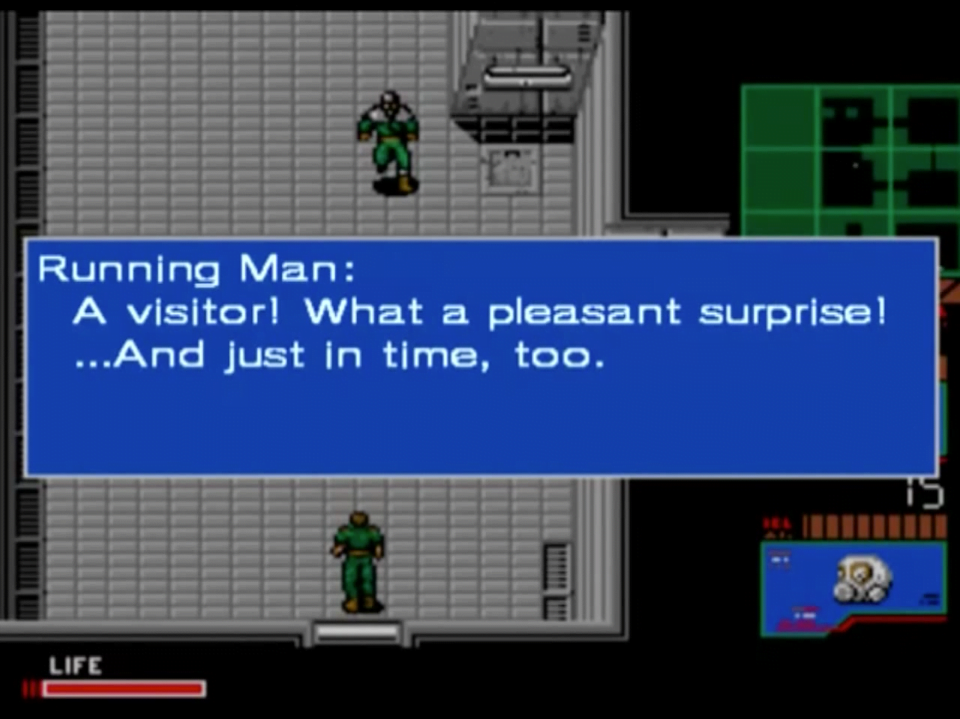To: Sean Gandert
From: Blake Foley
Subject: RE: The Phantom Sequel
Dear Sean,
The inventory in Metal Gear 2: Solid Snake is unlike anything I’ve ever seen before in a video game, and I think you are on to something when you compare it to an adventure game. In many cases, it is almost as if Kojima and his team thought of the items in your inventory as the actual objects they were meant to represent, defying typical game logic. At first it was puzzling why I kept finding different types of rations in the game with different contents. They seemed functionally the same, and initially I chalked their existence up to Kojima just being Kojima, but later I discovered that the contents of the rations actually matter. As silly as it might be that the chocolate bar in one ration can neutralize acid that otherwise kills you instantly, it again helps to make the world of Metal Gear feel real. A ration isn’t just a thing that you use to heal; it is cheese and chocolate.
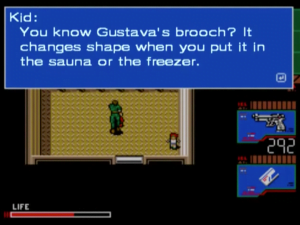 And that damn snake… I luckily came out of that without losing too many of my rations. I happened to open my inventory shortly after it hatched and immediately called Jacobson, the animal specialist. Jacobson told me how to deal with it and I was quickly snake free. I’m actually sorry to hear that that moment gave you some trouble. The way it played out for me was surprisingly engaging considering the low-res representation I was looking at. While it was all happening, I couldn’t help but picture Snake frantically digging through his pack trying to rid himself of the pest destroying his valuable food. The fact that it didn’t play out for you in that way reminds me of a long-standing problem in video games. It feels amazing when an interactive set-piece moment comes together in a game, but it’s remarkable how quickly the experience can go bad and the game’s world starts to break for the player if they don’t respond in the right way and in the right amount of time.
And that damn snake… I luckily came out of that without losing too many of my rations. I happened to open my inventory shortly after it hatched and immediately called Jacobson, the animal specialist. Jacobson told me how to deal with it and I was quickly snake free. I’m actually sorry to hear that that moment gave you some trouble. The way it played out for me was surprisingly engaging considering the low-res representation I was looking at. While it was all happening, I couldn’t help but picture Snake frantically digging through his pack trying to rid himself of the pest destroying his valuable food. The fact that it didn’t play out for you in that way reminds me of a long-standing problem in video games. It feels amazing when an interactive set-piece moment comes together in a game, but it’s remarkable how quickly the experience can go bad and the game’s world starts to break for the player if they don’t respond in the right way and in the right amount of time.
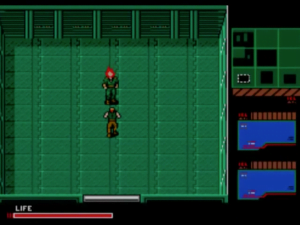 Is a game better or worse for having a moment that can play out so well for one player, but break for another? Call of Duty 4: Modern Warfare has a spectacular moment right at its finale. After an explosive chase, your truck flips over and you’re thrown from the vehicle. As you regain your wits, you see the game’s big baddie and two thugs walking towards you. Your commanding officer slides you a gun across the ground. You pick it up. The game goes into slow motion. You aim. You shoot… 9 out of 10 players drop the villains and see the credits roll. I didn’t… I missed one… I died, and I got to read a war quote while I waited for the sequence to load again. The sequence was supposed to make me feel like a badass, but it fell apart for me and I was immediately reminded that I was sitting in my room playing a video game. So many modern games have moments like this. Sometimes it’s a quick time event and other times it’s a platforming sequence, and it’s an issue that I always thought the Metal Gear series stayed away from, but now I’m wondering if there are other moments like these in future entries. It’s something I will definitely look out for as I replay the rest of the series. What do you think? These moments can be so powerful when they go right. Should the industry try to move away from them to ensure a more even experience across players? Or do the highs justify the lows? Would Metal Gear 2 have been better off presenting the snake moment as a cutscene rather than as gameplay?
Is a game better or worse for having a moment that can play out so well for one player, but break for another? Call of Duty 4: Modern Warfare has a spectacular moment right at its finale. After an explosive chase, your truck flips over and you’re thrown from the vehicle. As you regain your wits, you see the game’s big baddie and two thugs walking towards you. Your commanding officer slides you a gun across the ground. You pick it up. The game goes into slow motion. You aim. You shoot… 9 out of 10 players drop the villains and see the credits roll. I didn’t… I missed one… I died, and I got to read a war quote while I waited for the sequence to load again. The sequence was supposed to make me feel like a badass, but it fell apart for me and I was immediately reminded that I was sitting in my room playing a video game. So many modern games have moments like this. Sometimes it’s a quick time event and other times it’s a platforming sequence, and it’s an issue that I always thought the Metal Gear series stayed away from, but now I’m wondering if there are other moments like these in future entries. It’s something I will definitely look out for as I replay the rest of the series. What do you think? These moments can be so powerful when they go right. Should the industry try to move away from them to ensure a more even experience across players? Or do the highs justify the lows? Would Metal Gear 2 have been better off presenting the snake moment as a cutscene rather than as gameplay?
 As I write this, I’m still laughing at your comment about opening a book expecting Clifford and instead finding Hamlet. What would 17th century Kyle Schneider’s resume be? Kyle Schneider: The Bailiff, Alchemist, Millwright, Fishmonger?
As I write this, I’m still laughing at your comment about opening a book expecting Clifford and instead finding Hamlet. What would 17th century Kyle Schneider’s resume be? Kyle Schneider: The Bailiff, Alchemist, Millwright, Fishmonger?
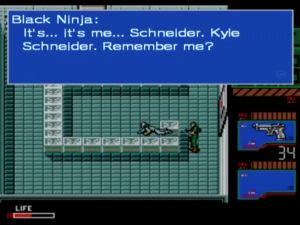 Anyway, Kyle Schneider is the most Metal Gear thing in Metal Gear 2, and is in a way one of the most important characters in the series. I don’t mean that he is massively important to the series’ story; rather, he is important to the series’ storytelling. You nailed it when you said he is proof that the story matters and no detail will be forgotten. Strap in, because there is plenty more of that as we get deeper into the series. Kojima and his team might not always have a reason for something at the time it is conceived, but they reserve and exercise the right to make it extremely important at any time in the future. Bosses in games are usually memorable because of the mechanics of their encounter, but the fight against Kyle is pretty bland. Kyle is memorable because of what he does for the series. He, like Steve, expands the Metal Gear universe. He questions the motivations of Snake’s leaders and in doing so increases the depth of the fiction by magnitudes. Snake’s fight isn’t always going to be as simple as good vs evil.
Anyway, Kyle Schneider is the most Metal Gear thing in Metal Gear 2, and is in a way one of the most important characters in the series. I don’t mean that he is massively important to the series’ story; rather, he is important to the series’ storytelling. You nailed it when you said he is proof that the story matters and no detail will be forgotten. Strap in, because there is plenty more of that as we get deeper into the series. Kojima and his team might not always have a reason for something at the time it is conceived, but they reserve and exercise the right to make it extremely important at any time in the future. Bosses in games are usually memorable because of the mechanics of their encounter, but the fight against Kyle is pretty bland. Kyle is memorable because of what he does for the series. He, like Steve, expands the Metal Gear universe. He questions the motivations of Snake’s leaders and in doing so increases the depth of the fiction by magnitudes. Snake’s fight isn’t always going to be as simple as good vs evil.
The same reveal also touches on a theme that will continue to show up throughout the series. As he dies, Schneider opens up to Snake, saying, “I was almost killed, but not by them. By you, and your country. …You’re no different, [your country] will forget about you too. …I owe you a debt. There is no hate between us.” Kyle Schneider specifically states that Snake had a hand in the deaths at Outer Heaven, but holds no ill will towards Snake. Snake is a soldier, and soldiers are merely tools used by governments to clean up after themselves.
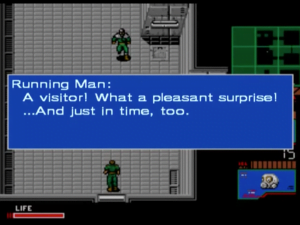 One other boss really stands out to me in Metal Gear 2: Solid Snake, but for very different reasons. I don’t know if it was intended, but Running Man comes across as a very sad character to me. We find out from George Kasler that Running Man set the world record for the 100 meter dash in the ’92 Barcelona Olympics, beating the contemporary real world record by 20 seconds. He became a mercenary sometime after he was busted for doping. We meet him in a four screen room and he is quick to demonstrate his speed. The demonstration fascinates me. He runs off screen and we can see his dot moving through the rest of the area on our radar. The speed he exhibits is far from remarkable. To top it off, he is breathing hard when he returns. To me, Running Man comes off as a man that lost everything after he was busted for steroid use and is desperately trying to convince himself he is still worth a damn. The alternative is that Kojima and crew made a bad cutscene. I prefer my version, but I’m curious what you think. Either way, I love that the series gives me an opportunity to think more deeply on a character like this. Regardless of Kojima’s intent, I’ll always remember Running Man as a pretty tragic character.
One other boss really stands out to me in Metal Gear 2: Solid Snake, but for very different reasons. I don’t know if it was intended, but Running Man comes across as a very sad character to me. We find out from George Kasler that Running Man set the world record for the 100 meter dash in the ’92 Barcelona Olympics, beating the contemporary real world record by 20 seconds. He became a mercenary sometime after he was busted for doping. We meet him in a four screen room and he is quick to demonstrate his speed. The demonstration fascinates me. He runs off screen and we can see his dot moving through the rest of the area on our radar. The speed he exhibits is far from remarkable. To top it off, he is breathing hard when he returns. To me, Running Man comes off as a man that lost everything after he was busted for steroid use and is desperately trying to convince himself he is still worth a damn. The alternative is that Kojima and crew made a bad cutscene. I prefer my version, but I’m curious what you think. Either way, I love that the series gives me an opportunity to think more deeply on a character like this. Regardless of Kojima’s intent, I’ll always remember Running Man as a pretty tragic character.
 I want to talk about Gray Fox, but I actually don’t have a lot to say. It feels like the game wants us to really care about his betrayal, but never really earns it. Our contact with Gray Fox in the first game was minimal, and he is suddenly sprung on us as a big reveal in the second. It is funny to me that Kyle Schneider impacted us both so much more. What do you think? At the very least, a fist fight in a minefield is pretty awesome.
I want to talk about Gray Fox, but I actually don’t have a lot to say. It feels like the game wants us to really care about his betrayal, but never really earns it. Our contact with Gray Fox in the first game was minimal, and he is suddenly sprung on us as a big reveal in the second. It is funny to me that Kyle Schneider impacted us both so much more. What do you think? At the very least, a fist fight in a minefield is pretty awesome.
I should wrap this up, but I’m just now realizing we haven’t talked much about the supporting crew in Metal Gear 2. Do any of them stand out for you this time around? Master Miller is a lunatic and Jacobson seems like a bit of a jerk, but nobody on Snake’s team left a lasting impression for me. Did any for you? We’ll get to know a few of them a bit better in future entries, but here they felt pretty thin even with the ample dialogue they were given. I’m curious what you think.
– Blake

